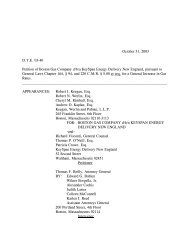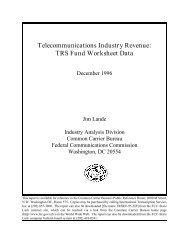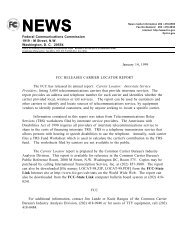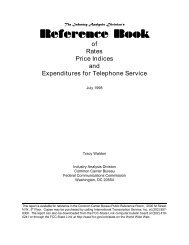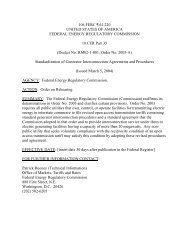Telecommunications Provider Locator - FCC
Telecommunications Provider Locator - FCC
Telecommunications Provider Locator - FCC
You also want an ePaper? Increase the reach of your titles
YUMPU automatically turns print PDFs into web optimized ePapers that Google loves.
<strong>Telecommunications</strong> <strong>Provider</strong> <strong>Locator</strong><br />
This report lists the contact information and the types of services sold by 5,679<br />
telecommunications providers operating as of December 31, 2000. All information in this report<br />
is drawn from providers’ April 1, 2001 filing of the <strong>Telecommunications</strong> Reporting Worksheet<br />
(<strong>FCC</strong> Form 499-A). This report can be used by customers to identify and locate<br />
telecommunications providers, by telecommunications providers to identify and locate others in<br />
the industry, and by equipment vendors to identify potential customers.<br />
Virtually all providers of telecommunications must file <strong>FCC</strong> Form 499-A each year. 1 These<br />
forms are not filed directly with the <strong>FCC</strong> but rather with the Universal Service Administrative<br />
Company (USAC), which serves as the data collection agent. The worksheets were due April 1,<br />
2001, but some providers filed late or updated their filing after that date. By October 1, 2001,<br />
the database contained contact information and revenue data from 5,679 filers. Information from<br />
filings received after October 1 and from filings that were incomplete has been excluded from<br />
the tables.<br />
Although many telecommunications providers offer an extensive menu of services, each filer is<br />
asked on Line 105 of <strong>FCC</strong> Form 499-A to select the single category that best describes its<br />
telecommunications business. Table 1 lists the categories from which the filer can choose and<br />
the number of filers that selected each. Note that in some cases, filer selections were changed<br />
based on supplemental information.<br />
Table 2 shows the number of filers that reported revenues in each of ten broad service<br />
categories. Generally, filers earn revenues by providing telecommunications and other services<br />
as a carrier’s carrier and/or directly to end users. In these two broad areas, filers can derive<br />
revenues from the following specific services: local, mobile, payphone, operator services and<br />
prepaid calling cards, and/or other toll. Since many filers report revenues from the provision of<br />
more than one service, the sum of the numbers in Table 2 is greater than the number of<br />
individual filers.<br />
Table 2 also shows the number of filers required to contribute a portion of their interstate enduser<br />
revenues to maintain universal service. Most telecommunications providers are required to<br />
contribute to the universal service fund, but there are exceptions. Section 54.706 of the<br />
Commission’s rules requires all telecommunications carriers providing interstate<br />
telecommunications services, providers of interstate telecommunications that offer interstate<br />
telecommunications for a fee on a non-common carrier basis, and payphone providers that are<br />
aggregators to contribute to universal service. The primary reason only 2,124 of the 5,679 filers<br />
actually contribute to the universal service fund is that no contribution is required if a filer’s total<br />
1 There are certain exceptions. <strong>Provider</strong>s that offer telecommunications for a fee exclusively on a non-common<br />
carrier basis are not required to file if their total annual contribution to universal service would be less than $10,000.<br />
Government entities that purchase telecommunications services in bulk on their own behalf, public safety and local<br />
government entities licensed under Subpart B of Part 90 of the Commission’s rules, entities providing interstate<br />
telecommunications exclusively to government or public safety entities, broadcasters and various non-profit entities<br />
are not required to file. Finally, systems integrators that derive less than 5% of their systems integration revenues<br />
from the resale of telecommunications and entities that provide services only to themselves or to commonly owned<br />
affiliates need not file.<br />
1



